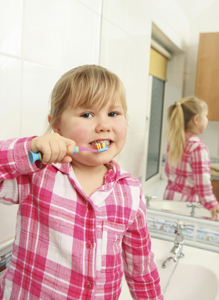Although you almost certainly learned to brush your teeth as a small child, it is quite possible that you are not currently using the best techniques. Perhaps you were taught incorrectly, or have gradually forgotten some important tips over the years. In addition, the rushed, frantic pace of modern life causes many people to cut corners in an effort to save time.
No matter what the reasons behind them, however, poor tooth brushing habits are a major factor in cavities, gum disease, and gradually worsening oral health. To keep your mouth as clean and healthy as possible, always follow these simple brushing best practices.
 Toothbrush and Toothpaste Selection
Toothbrush and Toothpaste Selection
Not all mouths are the same size, so choose a toothbrush that fits comfortably in your mouth and is easy to manipulate without pain. Always select soft bristles, as harder toothbrushes can damage tooth enamel. Many people find that an electric toothbrush is easier to use, as it has a bigger grip and it performs most of the work. However, any soft-bristled brush that feels comfortable is acceptable.
Choose a fluoride toothpaste that is approved by the ADA (American Dental Association). Some people like whitening toothpaste, a special formulation for sensitive teeth, or a particular flavor. Unless your dentist gives you a specific recommendation, feel free to select any approved toothpaste.
Replace your toothbrush at least three times per year, or whenever it looks worn. Once the bristles begin to fray, they can no longer do a good job of fully cleaning your teeth.
Brushing Angle and Toothbrush Movement
Begin by placing the toothbrush at a 45-degree angle to the front of your teeth. Start in one quadrant of your mouth, such as the upper left. Use short back and forth motions to thoroughly clean the front surfaces of all teeth in that quadrant. Then switch to the chewing surfaces, and finally to the backs of those teeth, using the same short back and forth strokes. Move on to the next quadrant and repeat the process, until all four quadrants are clean.
For the back surfaces of your front teeth, hold the brush at a near vertical angle, and brush straight up and down. After several repetitions, brush your tongue to remove bacteria and ensure that your breath is fresh and clean.
Timing Considerations
Even people who always use the best brushing techniques may not brush for the proper amount of time. It is important to spend 30 seconds on each quadrant of your mouth, for a total of two minutes of brushing. Brush your teeth after every meal if possible, or at least twice per day. If you have braces or dental problems, your dentist will instruct you on how often to brush and how to clean your teeth between brushing sessions.
Estimating time is surprisingly difficult, so it is best to set an alarm. Another option is to select an electric toothbrush that keeps time. Higher-end models beep every 30 seconds, letting you know when it is time to switch quadrants.
Flossing
Of course, brushing by itself is only part of good oral hygiene, even for those with flawless brushing technique. Floss at least once per day to remove bacteria and food debris from the spaces between the teeth and along the gums, where a toothbrush cannot reach.
Other Oral Hygiene Factors
While brushing and flossing are the most essential elements in keeping your mouth clean and healthy, a number of other factors can also affect your oral hygiene. Visit the dentist for a cleaning and checkup every six months, or as directed. Eat a balanced diet and reduce sugary snacks, and always rinse with clear water after eating sugary or sticky foods.
Ask your dentist about mouthwashes and rinses, oral irrigators, and other specialty items. Some merely add fragrance, while others are formulated to fight bacteria and reduce tooth decay.
Although brushing your teeth has probably been second nature since you were small, there is almost always room for improvement. Next time you start your oral hygiene routine, pay attention to the tips above. You might be surprised by how easy it is to get an even cleaner, healthier mouth.
Note that if you have dentures, braces, or other oral appliances, your normal brushing routine might need to be modified a bit. You might also need to clean and care for removable appliances separately. Ask your dentist if you have any concerns about proper oral hygiene.
Conveniently located in Woodbury, MN, Creekview Dental provides a progressive yet conservative approach to dental care. Our innovative, highly personalized procedures are focused on maintaining tooth structure and providing you with the healthy, beautiful smile you deserve. Call us today at 651-738-8204 to take the first steps on the road to better dental health.

